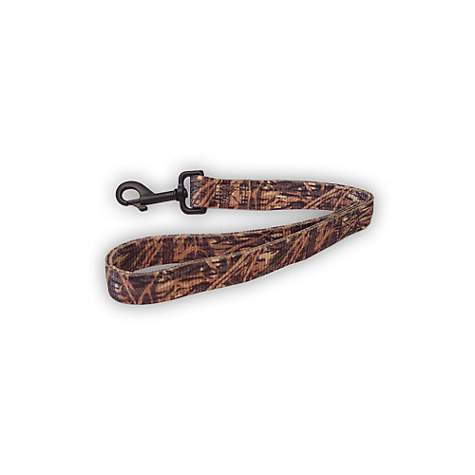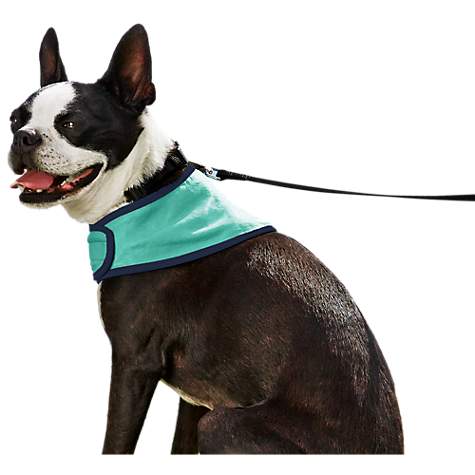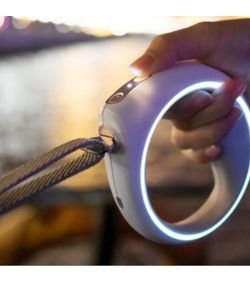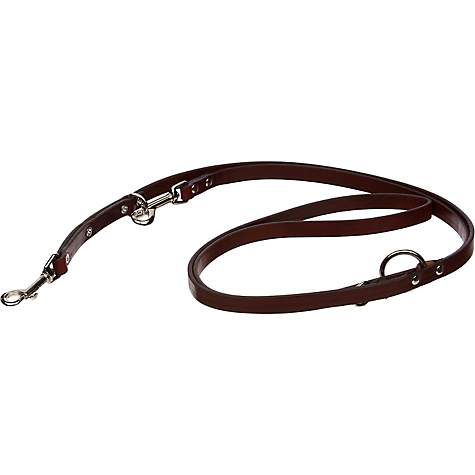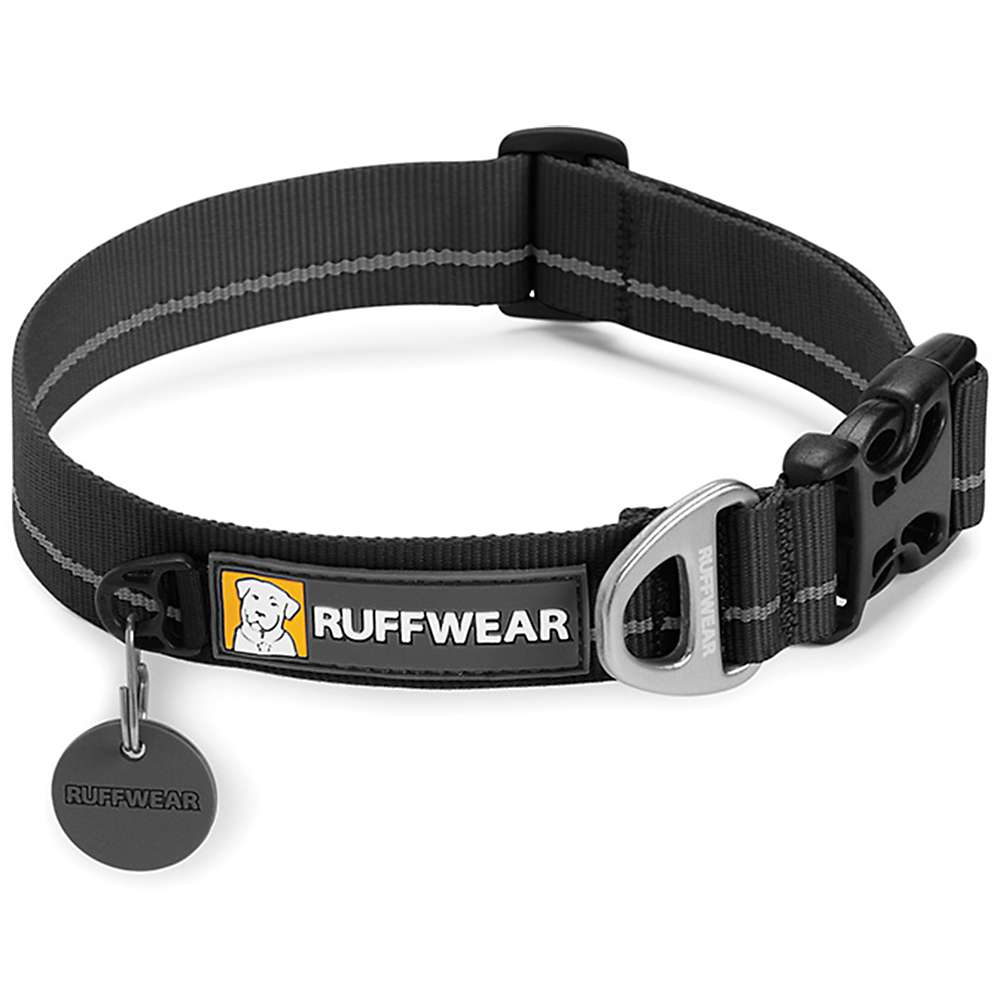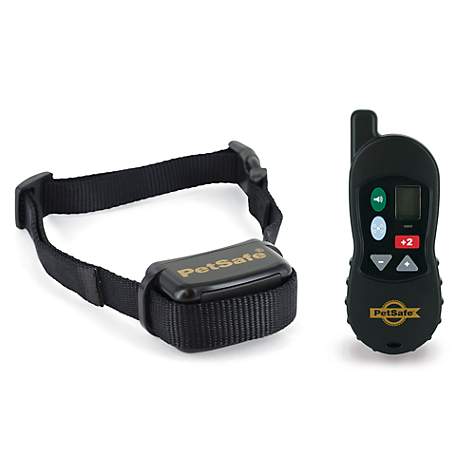Collars & Leashes - Best Fit and Use

When training the family dog there are several different types of training collars,walking harnesses, and leashes to choose from. It is important to match your dogs temperament and size with the appropriate training aids, and also consider that a Malamute is NOT a shepherd, rottie, golden. A puppy's every-day collar should be a flat buckle nylon collar (designed for everyday wear) or buckle rolled leather collar since both are better for the coat. We like and use the limited slip or martingale type collars - they are similar to a buckle collar, but can tighten slightly so they cannot be slid out of. There are several manufacturers and all have a different styles. You'll want a large "O" ring for easily attaching a leash or guy-line with gloves on - a plus with a dog that has heavy coat like a Malamute.
Inside the house use a 4 foot leash to help teach doggie manners. It's something that can be grabbed quickly to make a correction, but won't get in the way. Sometimes it helps use a hands free leash that attaches to your waist so that you are always nearby when training. If your puppy's size, strength and energy level becomes unmanageable you may need to experiment with a different training collar or walking harness to improve obedience and behavior. However, no collar is a substitute for training and mutual respect! Some useful training aids to help with obedience are:
Gentle Leader or Halti Collar - This collar consists of a snug fitting neck piece, and a loose fitting nose loop. This collar controls the dog's head movements. Some think it looks like a muzzle, however it in no way inhibits biting. It controls the entire head, which is helpfu for the owner. . The collar requires guidance rather than jerking or pulling on the strong neck muscles padded with coat - which is not very effective with Malamutes. The Halti Collar is similar looking and acts like a halter for a horse. The leash connects under the chin and no jerking or snapping is necessary. The halti collar is designed to control the canines head also. Where the head goes, the body follows! Using the correct size is important since dogs can escape these collars if not fitted properly. Put it on tightly the first few times since some dogs will fight the collar at first - but most stop as soon as they realize they will get to go for walks if they cooperate! Recently a very interesting article was brought to my attention regarding these collars which I find very interesting. Using ANY collar requires some training and my concern is many Malamute owners may improperly use the head halters in an attempt to solve all manner of dog behavior problems. It worked wonderfully with Shadow, but has not been so successful with Hoover who one day just decided to fight it continually. His attitude changed and it got to the point we made no progress at all. If you really need it for a dog that pulls, try it and give it a chance to work. But be aware of the issues involved. This collar is allowed in our contract because I feel it works for many dogs that need extra control - and is much safer and more humane than a pinch collar. The potential for misuse is not nearly as great as the prong or electronic collars mainly because you will likely give it up if your dog continues to fight it for too long, so the potential for damage is much lower.
Check Chain, Choke Collar, P-Collar - These collars are made of metal or nylon. They come in various sizes. The collar should form a right-facing P when you slip it over your canines head. These collars require a quick snap and release of the leash to work correctly and cannot be overused with a Malamute. They are best used on a young dog, since once the dog grows up, a snap of a choke collar is only a suggestion since with their strong necks, it is barely felt. Also, care must be taken to not drag or "choke" the dog since these collars can damage the windpipe if used improperly, especially on a young puppy. The collar should be tightened momentarily only when a correction is given. The collar size should be 2 - 4 inches longer than the diameter of the dogs neck. The collar must fit correctly to work correctly, and takes some practice to use effectively. Timing is everything with this type of collar, but if not overused and the jerk and release is done properly, can be an effective training tool. Don't leave this collar on the dog continually however, first there is a danger of strangulation if it gets tangled in something, and second it wears away and breaks the neck fur on a Malamute. I have seen rescue dogs that wore a chain collars with bare, bald infected necks due to the rubbing of the collar.
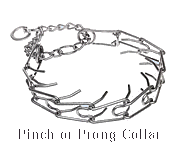 Pinch or prong collars. We don't recommend them at all and even though I have seen articles praising them, they seem draconian to me (my personal opinion). The main reason I feel they aren't good for Malamutes is when dogs pull on leash to approach another dog or person (normal behavior) and they feel pain from the collar, they connect the pain with the other dog or person and that can make them want to keep other dogs away by behaving aggressively. Anything used properly can be a good thing, and we know people that have had success with them, but we also know Malamutes that have become resentful and aggressive because of them - Shadow is our personal experience with this. Malamutes are trained quicker with positive reinforcement and creativity. Prong collars are also difficult to fit and use properly and this is probably the reason more people mess their dogs up. I would say for most people - avoid them - particularly with a dog that has tendencies to be dominant or aggressive. It's like playing with fire - whereas it may help, it can also create serious behavior problems. There are other opinions and the "pros" to this kind of collar. We forbid use of the prong or electronic collars for our puppies and dogs.
Pinch or prong collars. We don't recommend them at all and even though I have seen articles praising them, they seem draconian to me (my personal opinion). The main reason I feel they aren't good for Malamutes is when dogs pull on leash to approach another dog or person (normal behavior) and they feel pain from the collar, they connect the pain with the other dog or person and that can make them want to keep other dogs away by behaving aggressively. Anything used properly can be a good thing, and we know people that have had success with them, but we also know Malamutes that have become resentful and aggressive because of them - Shadow is our personal experience with this. Malamutes are trained quicker with positive reinforcement and creativity. Prong collars are also difficult to fit and use properly and this is probably the reason more people mess their dogs up. I would say for most people - avoid them - particularly with a dog that has tendencies to be dominant or aggressive. It's like playing with fire - whereas it may help, it can also create serious behavior problems. There are other opinions and the "pros" to this kind of collar. We forbid use of the prong or electronic collars for our puppies and dogs.
Remote Training collars - I'm not fond of these either. Electronic collars that emit a mild shock as a correction only serve to either errode your Malamute's trust in you or confuse them. . Malamutes have a high pain threshold and they are not that effective with most Malamutes. I've heard of them working, but often discovered later they shaved the dogs neck to get decent contact and set the shock higher than usual. The potential for misuse and hence, aggression is high so it's much better to use another method if possible. Whereas some have had great success, they are usually excellent trainers and would have been successful anyway, without an electronic collar. (Electronic collar training is the theory behind invisible electronic fencing which we also discourage.) There are collars that give a mild vibration or whiff of a scent. These can be used on a dog you take the time to train well. The vibration or sound is a reminder to get the dog's attention- not painful and not a punishment. These are much better if you want to use some kind of remote training system. Though you better have a fantastic recall because you will be competing with squirrels, bunnies and other dogs for your attention and a malamute might just think they are infinitely more interesting than you at that moment. So don't rely on these for everyday use. Only for a dog that is VERY well trained and VERY reliable (which most mals aren't).
Blind/Deaf/Reactive Dog color coded collars/leashes - collars that cool in hot weather, are colored specific colors and indicate a blind, deaf or easily triggered dog. These are great tools when you have a shy dog or one that is aggressiveor just needs space. These are fairly new on the market and if you use it out and about, make sure it is strong enough to control a malamute that has other ideas than your own. More below about this.
Tracking collars are also a new device. Some use GPS or a cell network to track a dog that has escaped from the yard. They usually aren't good for long distances, but may come in handy if you find that the dog has escaped fairly quicklybefore it's gone too far. Some are paired with a smart phone so if you are out looking for your dog, it will notify you when close, or show a spot on a map where his signal is receive. These are typically used more for hunting dogs - dogs trained to return when called.
The dog vest or harness. These are great for puppies. These give better control than a collar and there is no risk of it slipping off. They are also good for seniors that may need help getting up, or have cysts or tumors near the neck a collar would irritate. The down side is if worn all the time they tend to matt the fur underneath so will need to be removed and and the malamute brushed out regularly. Where it rubs on the fur it can chafe so make sure you find one that is padded but not too hot for a malamute to wear.
Show collars. These are like choke chain collars or p-collars but are usually made of a finer chain that won't damage coat. The same rules apply - they shouldn't be worn all the time.
Rolled Leather Collars These are sturdy and usually well made. The "roll" to the leather is much gentler on the coat than a flat collar so many people prefer these. The down side is they must fit extremely well or the dog can slip out of them, or if too tight, can cause damage to the dog's neck. If you get one for a puppy, check the fit often!
Flat buckle collar and LImited slip Collar These are your standard collars - usually made from a thick webbing or leather with a buckle or snap closure. If possible, get a metal closure because plastic ones don't hold up as well and the last thing you want is for it to break when you need it most. A limited slip is designed so that it tightens somewhat when the leach pulls on it, but otherwise is fairly loose around the neck. I like these the best because they are easy on the coat, but secure when out walking and not easy to slip out of like a normal buckle collar.
Leashes
For leashes, leather is easiest on the hands if the dog decides to pull, and 4 ft. has more control than 6 ft. though most obedience classes require a 6 ft. lead for training classes. For super control, get a "traffic" lead which is just a loop that attaches to the collar (about 8-10 inches long). I prefer the narrow kind of 6' leash (about 1/4"- 5/8" wide) because it's easier to fold up in your hand to shorten when necessary. I'm not fond of those 1" wide, double thick leashes...mainly because they are awkward and give you no better control or security than a less hefty leash. Nylon web leashes are great for expressing your individuality because they come in an infinite pattern variety, are washable, can be reflective and are secure. One kind of leash I won't recommend is a chain leash...they tend to break and are usually cheaply made.
A hands-free leash is one that lets you walk the dog hands-free - it attaches around your waist and is usually nylon webbing. They are usually very adjustable and can have a traffic lead loop, and can be shorter or longer when the length is adjusted.
Retractable leashes,  sometimes called flexileads, are pretty common to find in a dog owner’s stash of dog items. They do allow you to control the length of your dog’s leash and give them the freedom to roam a bit while still being under control. However, severe rope burncan occur if the leash gets caught around your ankle or if you try to grab the chord using your hand as your dog runs. If you like structure in your walk, a flexi really doesn't do it. Retractable leashes make it very difficult to teach your dog about leash pressure and tend to encourage pulling on the leash. If you are aware of the dangers, use with caution. They often do come with some nice features - lights, poop bags and storage compartments for treats and water that make them very popular.
sometimes called flexileads, are pretty common to find in a dog owner’s stash of dog items. They do allow you to control the length of your dog’s leash and give them the freedom to roam a bit while still being under control. However, severe rope burncan occur if the leash gets caught around your ankle or if you try to grab the chord using your hand as your dog runs. If you like structure in your walk, a flexi really doesn't do it. Retractable leashes make it very difficult to teach your dog about leash pressure and tend to encourage pulling on the leash. If you are aware of the dangers, use with caution. They often do come with some nice features - lights, poop bags and storage compartments for treats and water that make them very popular.
Traffic leads, are shorter and thicker than a typical 6' lead that lets you keep the dog closer when in a crowd or crossing streets.Double dog couplers allow you to walk 2 dogs on the same leash.
Whatever you use, keep your attitude positive and use lots of treats and playtime as rewards! Positive reinforcement is always the best training method with a Malamute regardless of the collar or leash you choose to use.
The color Coding Leash System (also collars and harnesses).
Did you know there is a color coding system used by dog owners to signify specific health or behavioural issues their pet may have? Coloured leashes and ribbons are a great way to indicate if your dog is aggressive, blind or in training. Even if your dog doesn’t fall into any of these categories, it’s an important thing to be aware of so you can detect potential issues with other dogs you may come across when out for a walk. These items help give dogs of all breeds the voice they need to let strangers know what their personality is before they are approached, making dog walking more enjoyable for everyone.

Another option for dog owners is to use coloured ribbons or bandanas that follow the same colour coding as seen above tied in a prominent spot on a dog’s leash. Unfortunately, until the system becomes more widely known, colored ribbons are not as likely to be as effective as a bright color and the meaning spelled out. It is important to know that these dogs are not necessarily aggressive but can be uncomfortable or nervous around strangers, may be experiencing pain from a recent surgery, or not fully trained. The red ribbon is also common and signifies that the dog may be aggressive if approached by a person or another animal.Whatever color the dog is wearing, it's always important to ask first before you pet or let your dog interact.
Spreading the word about the use of coloured collars, leashes and ribbons is the first step in encouraging responsible pet ownership and can help ensure dogs are given the space and support they need when out for a walk.
In conclusion, for safety, never leave ANY training collar on a dog when unsupervised as it presents a choking hazard if caught on something. It is also a good habit to take off collars when dogs are in crates (though this can be inconvenient and there's probably a bigger risk if you forget to put it back on). Also, it's probably wise to NOT use a flexi/retractable leash around children as they could easily become tangled in it. Be aware dogs have strangled from just playing wearing collars (one dog's mouth becomes entangled in the other's collar) so be aware and supervising when multiple dogs play together. Collars are a good tool that comes with some risk, use them properly.








